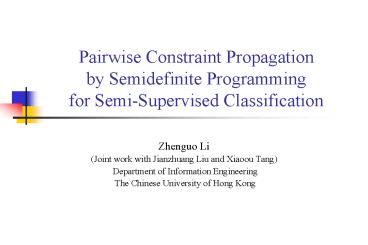Pairwise Constraint Propagation by Semidefinite Programming for SemiSupervised Classification - PowerPoint PPT Presentation
1 / 21
Title:
Pairwise Constraint Propagation by Semidefinite Programming for SemiSupervised Classification
Description:
Department of Information Engineering. The Chinese University of Hong Kong. 2. Outline ... implicitly obtain the feature map by explicitly pursuing the ... – PowerPoint PPT presentation
Number of Views:60
Avg rating:3.0/5.0
Title: Pairwise Constraint Propagation by Semidefinite Programming for SemiSupervised Classification
1
Pairwise Constraint Propagation by Semidefinite
Programming for Semi-Supervised Classification
- Zhenguo Li
- (Joint work with Jianzhuang Liu and Xiaoou Tang)
- Department of Information Engineering
- The Chinese University of Hong Kong
2
Outline
- Semi-Supervised Classification
- Our Work
- Experimental Results
- Conclusions and Future Work
3
Traditional Semi-Supervised Classification
- Learning from labeled and unlabeled data.
- Assumption
- Nearby objects tend to be in the same class
(cluster assumption). - Idea
- The known class labels are propagated smoothly to
unlabeled data (label propagation).
4
Challenges
- The distributions of real-world data are often
more complex than expected where - a class may consist of multiple separate groups.
- different classes may be close or overlapped.
- Pairwise constraints are natural in these
circumstances, which specify whether two objects
are in the same class or not (must-link and
cannot-link). - Techniques for label propagation are not readily
extended to handle pairwise constraints.
5
Our Work
- We consider the general problem of classifying
from pairwise constraints and unlabeled data. - It is more general than traditional
semi-supervised classification. - In contrast to label propagation, we attempt to
explore an approach for pairwise constraint
propagation.
6
A Toy Classification Example
7
The Global Viewpoint
- The must-link constraint asks to merge the outer
and inner circles into one class - The cannot-link constraint asks to keep the
middle and outer circles into different classes.
8
Our Assumptions
- Cluster Assumption
- Nearby objects should be in the same class.
- Pairwise Constraint Assumption
- Objects similar to two must-link objects
respectively should be in the same class - Objects similar to two cannot-link objects
respectively should be in different classes. - Our goal is to implement both the two assumptions
in a unified framework.
9
Our Idea
- Learn a nonlinear mapping to reshape the data
such that - Nearby objects are mapped nearby
- Two must-link objects are mapped close and two
cannot-link objects are mapped far apart - Objects similar to two must-link objects
respectively are mapped close, and objects
similar to two cannot-link objects respectively
are mapped far apart. - In doing so, the pairwise constraints will be
propagated to the entire data set.
10
The General Framework
11
Interpretation
- Constraint Satisfaction The inequalities require
two must-link objects to be mapped close and two
cannot-link objects to be mapped far apart. - Constraint Propagation By enforcing the
smoothness on the mapping, two objects similar to
two must-link objects respectively are mapped
close and two objects similar to two cannot-link
objects respectively are mapped far apart. - After the mapping, hopefully each class becomes
compact and different classes become far apart.
12
The Unit Hypersphere Model
- All the objects are mapped onto the unit
hypersphere. - Two must-link objects are mapped to the same
point. - Two cannot-link objects to be orthogonal.
- Smoothness measure
13
Learning a Kernel Matrix
- Let
- The matrix can be thought as a
kernel over the data set, where is just the
feature map induced by . - (Kernel Trick) We can implicitly obtain the
feature map by explicitly pursuing the
corresponding kernel matrix.
14
Learning a Kernel Matrix
- The constraints become
- The smoothness measure becomes
15
The SDP Problem
16
Kernel K-means
- Finally, we apply the kernel K-means to the
learned kernel matrix to obtain k classes of the
objects.
17
Experimental Results Toy Data
- Distance matrices before and after the mapping
18
Experimental Results UCI Data
19
Experimental Results Image Data
20
Conclusions
- We have proposed a framework PCP for learning
from pairwise constraints and unlabeled data - It can effectively propagate pairwise
constraints - It is formulated as a SDP problem.
- Future work includes
- accelerating PCP
- handling noisy constraints effectively
- applying PCP to practical applications.
21
Thank You!































